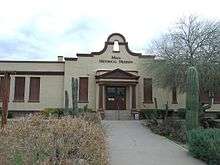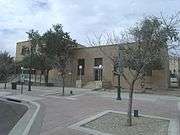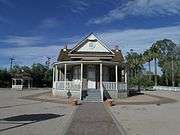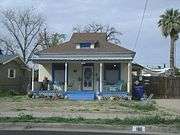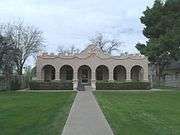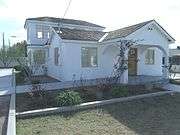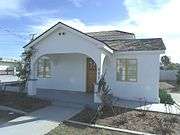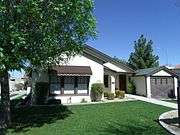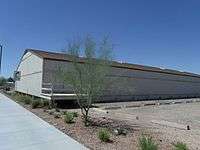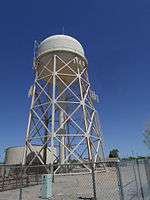List of historic properties in Mesa, Arizona
| List of historic properties in Mesa |
|---|
|
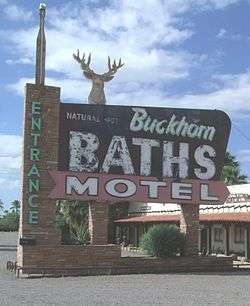
Sign of the historic Buckhorn Baths Motel |

Location in Maricopa County and the state of Arizona |
This is a list, which includes a photographic gallery, of some of the remaining historic structures and monuments in Mesa, Arizona.
Mesa
Mesa is a city in Maricopa County located east of Phoenix. Mesa is the third largest city in Arizona, after Phoenix and Tucson.
There are numerous properties in Mesa which are historical and which have either been listed in the National Register of Historic Places or in the list of the Mesa Historic Properties. The Mesa Historic Preservation Program, established by the city, facilitates public knowledge understanding and appreciation of the City's historic past.[1][2][3]
The city of Mesa cannot keep the private owners of the properties from demolishing them. Before a structure in a historic district or landmark can be demolished it must receive approval from the Historic Preservation Officer. A permit of demolishment will be provided if the property represents an immediate hazard. Other requests will be denied for a period of six months, in which time the Historic Preservation Officer will look for ways to save the structure. The structure may be demolished if at the end of the six months a plan to save the structure has not been established [4][5]
Included and pictured in this list are the historic properties which are located in what once was Williams Air Force Base. The base was once an active training base for the United States Army Air Forces, which later became the United States Air Force. The base closed in 1993. Part of the base was annexed by Mesa and the other part by the city of Phoenix. The area in which the base was located has been converted into a civilian airport called the Phoenix-Mesa Gateway Airport and an educational campus anchored by the Arizona State University and Chandler-Gilbert Community College.[6]
The following are images of some of these properties with a short description of the same.
Buildings and Houses of religious worship
Historic buildings and houses of religious worship in Mesa
(NRHP = National Register of Historic Places)
(MHP = Mesa Historic Properties)[4] |
|---|
| Replica of the original Lehi School built in 1880 (MHP). |
| The First United Methodist Church was built in 1894 and is located at 15 E. First Ave. The Methodist Church is the oldest one still in continuous use in Mesa. In 1893, Dr. E.W. Wilbur paid $300 dollars for two parcels where the church was to be built. In 1893, the church was chartered and its’ first constructed in 1894. It is listed in the Mesa Historic Property Register. |
| Lehi School, built in 1913 (NRHP) Historic Significance: Architecture/Engineering, Event, Architect, builder, or engineer: WPA, Architectural Style: Moderne, Mission/Spanish Revival, Area of Significance: Architecture, Community Planning And Development, Entertainment/Recreation, Education. Period of Significance: 1950–1974, 1925–1949, 1900–1924. |
| The Mount Calvary Baptist Church was built in 1918 and is located at 1720 E. Broadway Ave. Mt. Calvary Baptist Church is the oldest predominantly Black Church in Mesa. In 1918, the late Reverend J.B. Bell organized the mission into a formal church. These early members gave the church the name it bears today, Mt. Calvary Baptist Church. The church is listed in the Mesa Historic Property Register. |
| The historic Alhambra Hotel was originally built in 1893 and reconstructed in 1922. It was listed in the National Register of Historic Places on July 31, 1991. |
| Mesa Women's Club, built in 1931 (NRHP) Historic Significance: Event, Area of Significance: Social History, Period of Significance: 1925-1949. |
| Historic Post Office/Federal Building, built in 1937, (MHP). |
| Irving School was built in 1936 and it is located at 155 N. Center St. The Irving School is a rare surviving example of Federal Modern style architecture applied to an elementary school. The school was listed in the National Register of Historic Places on November 8, 2000, reference number 00001323. |
| Different view of the Irving School . |
| The Buckhorn Baths Motel was built in 1939 and is located at 5900 Main St. in Mesa. The Buckhorn Baths Motel is a complex consisting of fourteen buildings including a bathhouse, a main office building, and individual room units. The motel was listed in the National Register of Historic Places on May 10, 2005, reference number #05000421. |
| Some of the individual room units of The Buckhorn Baths Motel which was built in 1939 and is located at 5900 Main St. in Mesa. The Buckhorn Baths Motel was listed in the National Register of Historic Places on May 10, 2005, reference number #05000421. |
| The historic Queen of Peace Church was built in 1947 and is located at 141 N Macdonald Rd. It is a non-Indian parish that has had a few Maya Indian parishioners. |
| The Information Technology Department Building was built in 1959 and is located at 59 E. 1st St. It was built as the Mesa Public Library, it is an early example of post-World War II modern formalism architecture. It is listed in the Mesa Historic Property Register. |
|
Houses
Historic houses in Mesa, Arizona
(NRHP = National Register of Historic Places)
(MHP = Mesa Historic Properties)[4] |
|---|
| Sirrine House, built in 1896 (NRHP) Historic Significance: Architecture/Engineering, Architect, builder, or engineer: Sirrine, Joel E., Architectural Style: Queen Anne, Area of Significance: Architecture, Period of Significance: 1900-1924, 1875-1899. |
| Angulo-Hostetter House, built in 1902 (NRHP) Historic Significance: Architecture/Engineering, Architectural Style: Colonial Revival, Queen Anne, Area of Significance: Architecture, Period of Significance: 1925–1949, 1900–1924. |
| Strauch-Fuller House, built in 1906 (NRHP) Historic Significance: Architecture/Engineering, Architect, builder, or engineer: Unknown, Architectural Style: Mission/Spanish Revival, Area of Significance: Architecture, Period of Significance: 1900-1924. |
| The Robert Scott House was built in 1909 and is located at 2230 E. Grandview St. in Mesa. The residence belonged to Robert Scott, a wealthy Mesa sheep farmer and large landowner, who was a co-founder of the Salt River Bank. The Scott House originally stood within the original Mesa townsite on the corner of First and Sirrine Streets, and when completed was among the few large formal residences in Mesa. Commercial expansion and downtown redevelopment projects during the past twenty years have changed the character of the townsite area. The original site of the Scott House was sold for commercial development in 1972, and the house was subsequently moved six miles to a residential subdivision where it is now located. The property was listed in the National Register of Historic Places on July 8, 1982, reference #82002079. |
| Spangler-Wilbur House, built in 1915, (NRHP) Historic Significance: Architecture/Engineering, Architect, builder, or engineer: Home Builders Inc., Architectural Style: Colonial Revival, Mission/Spanish Revival, Area of Significance: Architecture, Period of Significance: 1900-1924. |
| James A. Macdonald House, built in 1916-1918 (MHP). Macdonald was an early Mesa Pionee. He was a former police officer, farmer, and builder and helped in the construction of the Arizona LDS Temple. |
| Dr. Lucius Charles Alston House, built in 1920 (NRHP). The Dr. Lucius Charles Alston House is associated with the history of the development of the African American community in Mesa. The house served as Dr. Alston’s office while practicing medicine in Mesa. |
| Different view of the Dr. Lucius Charles Aston House. |
| Mesa Journal--Tribune FHA Demonstration Home. Also known as Charles A. Mitten Home. Area of Significance: Commerce, Community Planning And Development; Period of Significance: 1925-1949 (NRHP). |
| The Fitch Farm House was built in 1933 and is located at 945 N. Center Street. The farm belonged to Larkin Fitch. He married Mildred Dobson, daughter of John Dobson. Larkin Fitch played a prominent role in the farming industry in Mesa. The Fitch Farm House is an example of a Tudor Revival style house (MHP). |
| The Ramon Garcia Mendoza House was built in 1944 and is located at 126 N. Pomeroy Lane. Ramon Garcia Mendoza was the first Hispanic Chief of Police in Mesa. He became a police officer in a time when segregation was still practiced in the City. Mendoza was appointed Police Chief in 1969 and served as such until his retirement in 1978. It is listed in the Mesa Historic Property Register. |
| The Ponderosa II House (Lorne Greene's house) was built in 1960 and is located at 602 S. Edgewater Dr. The house was built by actor Lorne Greene, who played Ben Cartwright, the patriarch of the Cartwright family in the popular 1960s TV series “Bonanza”. The house is a replica of Bonanza’s Ponderosa Ranch House. It is listed in the Mesa Historic Property Register. |
| Different view of the Ponderosa II House (Lorne Greene's house) which was built in 1960 and is located at 602 S. Edgewater Drive. |
|
Historic structures in what once was Williams Air Force Base
Williams Air Force Base
(now part of Phoenix–Mesa Gateway Airport)
(NRHP = National Register of Historic Places)
(MHP = Mesa Historic Properties) |
|---|
| Housing Storage Supply Warehouse at Williams Air Force Base (now Arizona State University at the Polytechnic campus). The housing supply warehouse was constructed in December 1941 by Del E. Webb Construction Company. The housing supply warehouse is significant for its association with the initial development and construction at Williams Air Force Base. Listed in the National Register of Historic Places – 1995. Reference 95000746 |
| Water Tower at Williams Air Force Base (now Arizona State University at the Polytechnic campus). The water tower was constructed in the winter of 1941-1942 by the Del E. Webb Construction Company. The water tower possesses the associative quality that connects it to the history of Williams Air Force Base. Listed in the National Register of Historic Places – 1995. Reference 95000745 |
| The Flagpole was built in December 1941, the Base Flagpole is significant as an object for its important symbolic and traditional associations with the origins and history of Williams Air Force Base (now Phoenix-Mesa Gateway Airport). The pole was erected by Del E. Webb Construction Company. Listed in the National Register of Historic Places – 1995 Reference 95000744. |
| Marker of the historic flagpole. |
| Demountable Hangar located at the North Apron, Phoenix-Mesa Gateway Airport (formally Williams AFB), Mesa, Arizona. Built in 1925 and designed by Webb, Del E., Construction Company to resemble an enlisted aviator badge of the Army Air Force. Listed on the National Register of Historic Places in 1995, ref. #95000743. |
| Ammo Bunker (S-1007), SW of Vosler Dr. (formerly Alaska Dr.), at Arizona State University at the Polytechnic campus (Formally Williams AFB), Mesa, Arizona. Built in 1925 by Webb, Del E., Construction Company. Listed in the National Register of Historic Places ref: 95000748. |
| Sealed entrance of Ammo Bunker (S-1007). |
| Ammo Bunker (S-1008), SW of Vosler Dr. (formerly Alaska Dr.) , at Arizona State University at the Polytechnic campus (Formally Williams AFB), Mesa, Arizona. Built in 1925 by Webb, Del E., Construction Company. Listed in the National Register of Historic Places ref: 95000759. |
| Sealed entrance of Ammo Bunker (S-1008). |
| Civil Engineering Maintenance Shop also known as S-735, located in Unity Ave. (Jct. of 11th and A Sts.), at Arizona State University at the Polytechnic campus (Formally Williams AFB), Mesa, Arizona. Listed in the National Register of Historic Places in 1995, ref: #95000747. |
|
Mesa Grande Ruins
Mesa Grande Cultural Park
 Entrance of the Mesa Grande Cultural Park
(NRHP = National Register of Historic Places)
(MHP = Mesa Historic Properties) |
|---|
| The Mesa Grande Temple Mound is located in the Mesa Grande Cultural Park at 1000 N. Date St. Built by the Hohokam in 1100 AD. The walls are made of “caliche”, the calcium carbonate hardpan that forms under the desert soils. The mound is longer and wider than a modern football field (note: U.S. Football) and is 27 feet high. The Mesa Grande Cultural Park was listed in the National Register of Historic Places on November 21, 1978, reference number 78000549. |
| Different view of the Mesa Grande Temple Mound, built c. 1100 AD and located in the Mesa Grande Cultural Park at 1000 N. Date St. The Mesa Grande Cultural Park was listed in the National Register of Historic Places on November 21, 1978, reference number 78000549. |
| A large plaza in front of the Mesa Grande Temple Mound which was enclosed by a large adobe wall. The plaza is located in the Mesa Grande Cultural Park at 1000 N. Date St. The Mesa Grande Cultural Park was listed in the National Register of Historic Places on November 21, 1978, reference number 78000549. |
| One of the two largest networks of irrigation canals created in the prehistoric Americans by the Hohokams. It is located in the Mesa Grande Cultural Park at 1000 N. Date St. The Mesa Grande Cultural Park was listed in the National Register of Historic Places on November 21, 1978, reference number 78000549. |
| Replica of the Mesa Grande Hohokam Ballcourt . The ballcourt, which is located at 1000 N. Date St., is an open-air structure where the Hohokam played ballgames using a rubber ball made from a local plant. The Mesa Grande Cultural Park was listed in the National Register of Historic Places on November 21, 1978, reference number 78000549. |
|
Park of the Canals
Park of the Canals
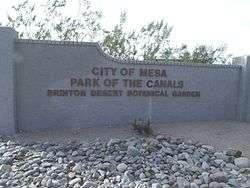 Entrance to the Park of the Canals located at 1710 N Horne Ave.and listed in the National Register of Historic Places on May 30, 1975, reference number 75000350.
(NRHP = National Register of Historic Places)
(MHP = Mesa Historic Properties) |
|---|
| Park of the Canals National Register of Historic Places Marker. |
| This is an ancient Hohokam canal cleaned out by the Mormon pioneers in 1875. |
| This is a prehistoric canal built by the Hohokams. |
|
City of Mesa Cemetery
The City of Mesa Cemetery was established in 1891 and is located at 1212 N. Center Street. Among the many notable citizens of that city which are interred there are the following:[7][8]
- Dr. Lucius C. Alston (1892–1958). Dr. Alston was the first African-American doctor to serve Mesa. His house is listed in the National Register of Historic Places, reference number 12000240.[7]
- Oscar Virgil Crismon (1909-1985). Crismon served as Mayor of Mesa from 1950-1952.
- George Nichols Goodman (1885–1959). Goodman served as Mayor of Mesa during the following years: 1938–1942, 1946–1948 and 1952–1956.
- Pedro Warner Guerrero (1896–1995). Guererro was the founder of the Guerrero-Lindsey Sign Company. In 1946, with R.G. Scarborough and Ann Encke, he founded the Rosarita Mexican Foods Company. It has become a national brand. Mesa's Pedro Guerrero Rotary Park is named for him.[9][10]
- William Johnson LeBaron (1856–1929) served as Mayor of Mesa from 1888 to 1896.
- Collins Rowes Hakes (1837–1916) and Mabel Ana Morse Hakes (1840-1909). Collins Rowes Hakes, together with Riley Morse and Orlando and Orin Merrill, was the first to discover gold in the Goldfield area by the Superstition Mountains. His wife was president of the Mesa Ward Relief Society for five years and counselor and then president of the Maricopa Stake Relief Society, and was the Mesa representative to the Woman’s Suffrage Convention in Chicago in 1893.
- Waylon Jennings (1937–2002). Jennings was an American singer, songwriter, musician, and actor. Jennings gave up his seat on the ill-fated flight that crashed and killed Buddy Holly, J. P. Richardson, Ritchie Valens, and pilot Roger Peterson. In 2001, he was inducted into the Country Music Hall of Fame.[11]
- Ramon Garcia Mendoza (1914–1999). R.G. Mendoza was the first Hispanic police chief in Mesa. His house is listed in the Mesa Historic Property Register. He was the son of Ramon Somoza Mendoza.
- Ramon Somoza Mendoza (1876–1951). Mendoza was the first Hispanic police officer in Meza. The Mendoza Elementary School in Mesa was named in his honor. His son Ramon G. Mendoza, who led the department from 1969 to 1978, was Mesas' first Hispanic police chief.[12]
- Ernesto Arturo Miranda (1941–1976). Miranda was a laborer whose conviction on kidnapping, rape, and armed robbery charges based on his confession under police interrogation was set aside in the landmark U.S. Supreme Court case (Miranda v. Arizona), which ruled that criminal suspects must be informed of their right against self-incrimination and their right to consult with an attorney before being questioned by police. This warning is known as the Miranda Rights.[13]
- Ralph Fleetwood Palmer (1875–1954). Dr. Palmer served as Mayor of Mesa from 1910-1912.
- Orley Seymour Stapley (1872–1942). Stapley served in the Arizona State Senate from 1914 to 1915.[14] He established a chain of hardware stores throughout the state. Stapley Junior High School in Mesa was named in his honor.[15]
Also interred are the four founding fathers of Mesa:[16]
- Charles Crismon (1805–1890)
- Francis Martin Pomeroy (1822–1882)
- Charles Innes Robson (1837–1894)
- George Warren Sirrine (1818–1902). His house, the "Sirrine house", is listed in the National Register of Historic Places, reference number 95001082.
City of Mesa Cemetery
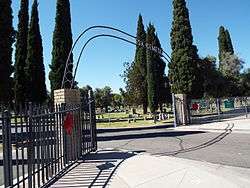 Entrance to the City of Mesa Cemetery |
|---|
| Grave of Dr. Lucius C. Alston (1892–1958), Block #683. |
| Grave of Charles Crismon, Block #76. |
| Grave of Oscar Virgil Crismon (1909–1985) and Helen H. Crismon (1917–2006), Block #888. |
| Grave of George Nichols Goodman (1885-1959) and Clara Platt Goodman (1898–1994), Block #424. |
| Grave of Pedro Warner Guerrero (1896–1995), Block #643. |
| Grave site of Collins Rowes Hakes (1837–1916) and Mabel Ana Morse Hakes (1840–1909), Block #70. |
| Grave of William Johnson LeBaron (1856–1929) and Zina S. LeBaron, Block #23. |
| Grave of Ramon Garcia Mendoza (1914–1999) and Mary Robles Mendoza (1916–1991), Block #165. |
| Grave of Ramon Somoza Mendoza and his wife Dolores Mendoza (1885–1957), Block #533. |
| Grave of Ernesto Arturo Miranda, Block #677. |
| Grave of Dr. Ralph Fleetwood Palmer (1875–1954), Block #123. |
| Grave of Francis Martin Pomeroy, Block #72. |
| Grave of Charles Innes Robson (1837–1894), Block #72. |
| Grave of George Warren Sirrine, Block #82. |
| Grave of Orley Seymour Stapley, Block #476. |
|
Further reading
- Mesa (Images of America: Arizona); by Lisa A. Anderson and Alice C. Jung; Publisher: Arcadia Publishing; ISBN 978-0738548425
See also
Other cities and towns in Arizona with articles of their historic properties
- List of historic properties in Bisbee, Arizona
- List of historic properties in Casa Grande, Arizona
- List of historic properties in Chandler, Arizona
- List of historic properties in Florence, Arizona
- List of historic properties in Flagstaff, Arizona
- List of historic properties in Glendale, Arizona
- List of historic properties in Goldfield, Arizona
- List of historic properties in Paradise Valley, Arizona
- List of historic properties in Peoria, Arizona
- List of historic properties in Phoenix, Arizona
- List of historic properties in Scottsdale, Arizona
- List of historic properties in Tempe, Arizona
- List of historic properties in Tombstone, Arizona
- List of historic properties in Wickenburg, Arizona
- List of historic properties in Winslow, Arizona
References



